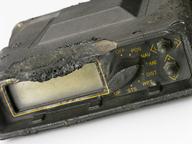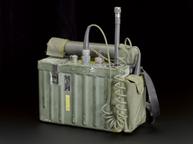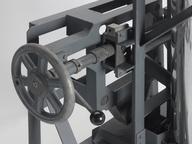




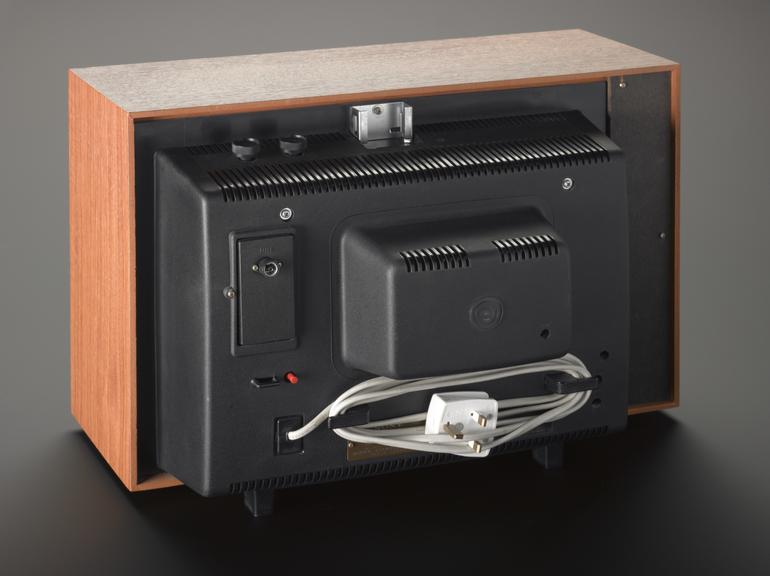
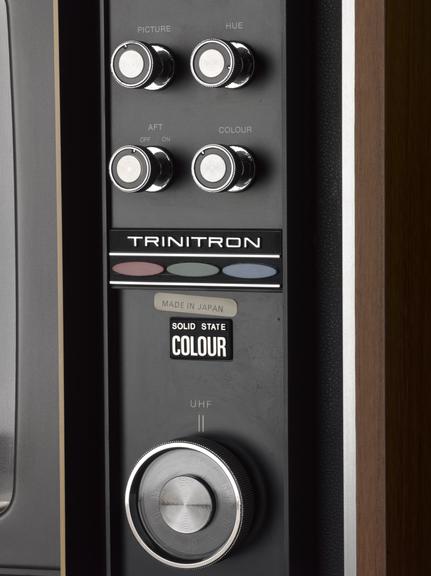

Sony 'Trinitron' colour television set, model type KV-1320UB, manufactured by Sony, Japan, 1969-1970. Serial No. 505704
The ‘Trinitron’, unveiled by Sony in Japan in 1968, was the first major technological advance in colour television sets since they were first introduced commercially in the early 1950s and offered new standards of picture quality.
The Trinitron was designed by a team of four lead engineers, Yoshida, Masaru Ibuka, Senri Miyaoka, and Akio Ohgoshi and was so-called because it had three cathodes in a line inside a single electron emitter or gun. The Trinitron was the result of a series of innovations including deflection plates above the gun to help focus the electron beams and the development of a chemical etching process to create a vertically aligned aperture grill comprising a large number of fine wires. The aperture grill replaced the ‘shadow mask’ (a plate perforated with a large number of tiny holes) of older colour television sets. The ‘shadow mask’ ensured that the appropriate phosphors on the inner coating of the cathode-ray tube screen responded to the appropriate colour signals from the tube's three electron guns. While an effective method, this cut down on the light output of the tube meaning that the picture was best viewed in subdued light.
The engineers at Sony came up with the better idea of a single electron gun with three cathodes, along with the aforementioned vertically aligned aperture grill. This meant that the cathodes needed to be aimed with great precision but a careful manufacturing technique made this possible. The method required a screen which was much flatter than previous cathode-ray tubes and this improved the presentation quality too. The result was a brighter and better focused picture than had previously been achieved. The outcome was a colour television set that could be mass-produced at an acceptable cost; was stable and rarely required professional adjustment after it was sold (as some previous systems had); and provided a superb colour picture.
Introduced in limited numbers in October 1968, the Trinitron was an instant hit. The improvements it offered in picture quality justified charging a premium – when the Trinitron was first introduced to the US in 1969 it cost $319.95 or about $2,200 in 2019 US dollars. The Trinitron was introduced in the UK in 1969. In 1973, the Trinitron became the first consumer electronics device to win an Emmy. Sony eventually sold 280 million Trinitrons, as both TVs and, later, computer monitors with production finishing in 2008.
This is one of the earliest models marketed in Britain, dating from around 1969 and the external finish and styling are very characteristic of its time. This initial 12-inch model (Science Museum Group object no 2014-67) was quickly followed by a larger models, including the KV-1320UB (Science Museum Group object no 1972-302).
Perhaps more importantly, the Trinitron vaulted Sony into the first rank of technology providers and helped finance Sony’s run of success in consumer electronics manufacturing, as well as that of Japan’s. Prior to the Trinitron, most electronic products from Japan were inexpensive and of suspect quality. The Trinitron was one of the foundational products establishing Japan as a world-class source of advanced electronics.
Details
- Category:
- Radio Communication
- Object Number:
- 2014-67
- Materials:
- wood (unidentified), plastic (unidentified) and metal (unknown)
- Measurements:
-
overall: 337 mm x 505 mm x 430 mm, 14.78 kg
- type:
- television receiver
- credit:
- Unknown Source

